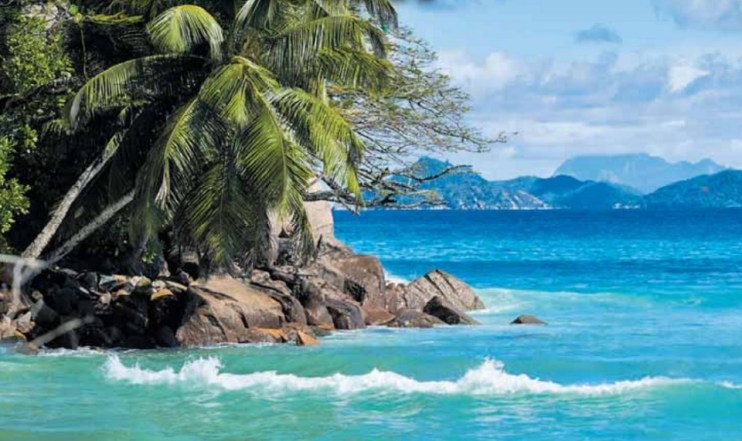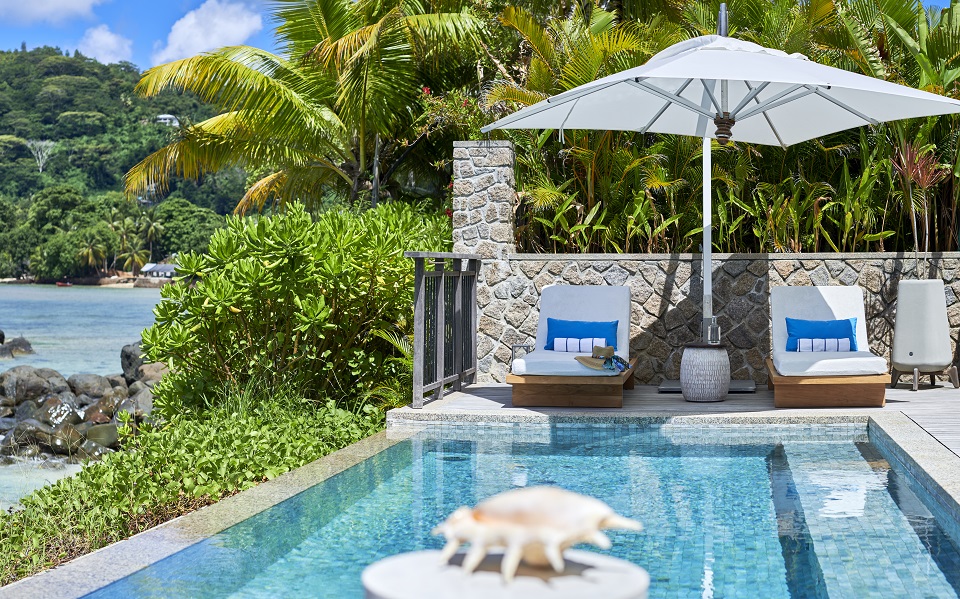The Seychelles holiday you need to book now

The Seychelles is thriving. Adam Hay-Nicholls checks into a recent opening to find creative inspiration
Seychellen luxury hotel Mango House will cause you to abandon your beach book and erect an easel. The charming staff have arranged for me not only a cold SeyBrew and towels, but a tray of acrylic paints. With the encouragement of a brilliant local artist, my creative juices are propelled onto canvas. Inspired by the vista of verdant palms and turquoise sea, born of a flurry of brushwork, the effect is as relaxing – and much more productive – than an afternoon in the soporific spa.
This particular paradise has its roots in the visual arts. Opened summer 2021, Mango House was originally the remote getaway of veteran photographer Gian Paolo Barbieri. Mr Barberi, who is known for his work for Vogue Italia and has shot Monica Bellucci, Audrey Hepburn, Naomi Campbell and Veruschka, turned his attention away from fashion to travel photography during the ‘90s. His adventures led him to the south of Mahé, the Seychelles’ main island.
Here he took award-winning images of the indigenous people, and designed his own personal base on the Anse aux Poules Bleues, a deserted bay. A couple of decades later, this family home has been tastefully expanded and converted into a lush LXR Resort – a prestige boutique offshoot from Hilton that focuses on “legendary properties in the world’s most alluring locations”, and this place undoubtedly ticks those boxes. The Hilton affiliation, and the Seychelles’ success in attracting wealthy western holiday-makers, meant I arrived in Mahé expecting Mango House to be a fairly generic five-star hotel, secluded behind high walls, with spoiled guests sprawled beside its various pools and never venturing outside the property.

In fact, it’s not like that at all. The south of the island is incredibly bohemian. There are loads of artists living here, both indigenous and ex-patriate, in communal harmony. It’s a creative and wonderfully at-ease oasis. We’re half an hour’s drive south of the airport – ideal if, after a minimum 13-hour plane ride, you don’t fancy transferring to one of the 115 other smaller islands. The north of the main island is where you’ll find busier (though still beautiful) beaches and bigger, blander resorts.
There are superyachts off the coast, several escaping Russian sanctions. During my visit, oligarch Alexei Mordashov’s 142- metre gin palace floats off the capital, Victoria. The south of the island is quieter and unspoilt, and Mango House feels like a private home more than a hotel. There are 41 rooms, which is not small, but they’re set back from the main house in a number of blocks that blend in with the rocks and are camouflaged behind foliage. Mine – Cliff House – offers its own pool. Each airy bedroom boasts narcolepticly soft net-festooned beds and small sea-view terraces. The private crescent-shaped beach is positively Bondian, and empty.
I see only maybe a dozen other guests around the resort, and usually not a single sun lounger is taken. It makes my friends and I feel like we’re not paying punters, but guests of a generous chum with a £20 million ocean villa. The main house, which is almost unrecognisable from when Barberi owned it but retains a fantastic sense of intimacy, is home to an even more sybaritic pool (there are three on the property in total), as well as the spa, gym, a rakish cocktail bar and three of a total four dining options – all of which are phenomenal.
The restaurant boasts a large family of elderly, giant and rather randy tortoises
They cover Italian, Japanese and Creole – the delicious local cuisine – with an emphasis on seafood, which arrives off the boats a five-minute walk away. Pretty much all feasting moods are covered here, and it’s ten-out-of-ten all-round. Nigel Henri is a sort of artist in residence. The chap who encouraged me with the brush (having barely picked one up since my art A-level) also has a TV show focusing on the culture and personalities of the Seychelles. His works, mainly oils of tropical fish, have been purchased by Tony Blair and Leonardo DiCaprio on their visits.
He’s the most wonderful guide to tour us around the island. We take a minibus to visit the pristine public beaches of Beau Vallon and Anse Louis. We lunch at Le Jardin du Roi in Victoria, an institution whose garden dates back to the first French settlers in 1770. I try the fruit bat curry (Nigel orders it at my insistence and offers me a bite). Edible enough, but certainly not pretty.
The same might be said of the restaurant’s large family of elderly, giant and rather randy tortoises. Nigel is, of course, the perfect guide to the south’s community of artists. Among the studios we visit is that of Michael Adams, literally next door to our hotel. Adams is the country’s most famous painter. He was born in Malaysia to British parents, settled in the Seychelles in 1972 with his wife Heather, and has never left. His colourful renderings of tropical nature have earned him an MBE, and his UK educated children are acclaimed artists in their own right, living on Mahé and selling their paintings alongside his on the walls of their childhood home.
Alyssa – the daughter – has designed the signature print for Mango House’s silk dressing gowns. Another ex-pat artist of 40 years standing is Tom Bower (not to be confused with the investigative journalist), whose sensual sculptures are created in a shed in his garden. The community welcomes high-end hotels and elite visitors because they bring spending power, allowing artists to dedicate themselves to their craft. I find particular joy in the Lazare Gallery. Its owner, known as Toto, mainly stocks a selection of Afrobeat cassettes, old Nokia burner phones and photographs of the Duke of Edinburgh.
Prince Phillip and Her Majesty visited the Seychelles on several official tours. Princess Margaret was also a fan, and she had excellent taste in R&R. Wills and Kate came here on their honeymoon, so it has lasting links to the House of Windsor. The islanders I speak with are quietly proud of their royal association, making a change from recent Caribbean headlines.
They’re also doing quite well for themselves. 800 miles off the Somali coast and considered part of Africa, the Indian Ocean archipelago has the highest average income per capita of any African nation. Perhaps that goes a small way to explaining why the staff at Mango House have such an easy going relationship with their guests. There’s no stuffiness, no nervousness. Their energy is warm and confident. They are attentive yet laid back.
Again, this feels so much more like a home from-home than a hotel, much less a Hilton. A year since it launched, Mango House is already seeing a large proportion of repeat guests, and that comes as no surprise. I would love to return, join Nigel for a SeyBrew, and maybe bring some watercolours next time. Rooms at Mango House start from around £500-a-night.
Visit the Seychelles
For more information, visit Hilton.com/en/hotels/sezitol-mango-houseseychelles/